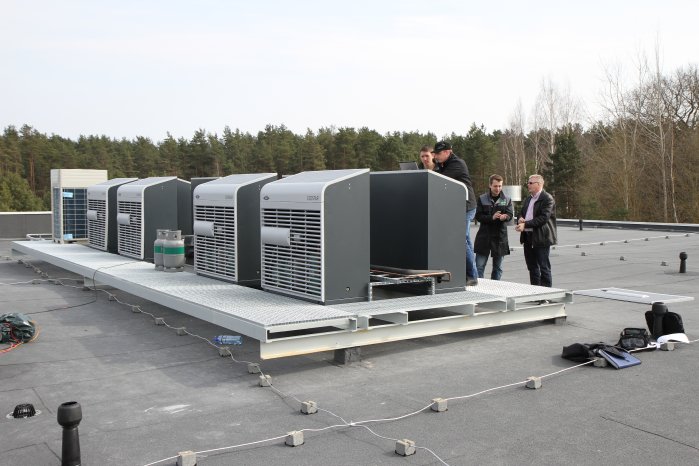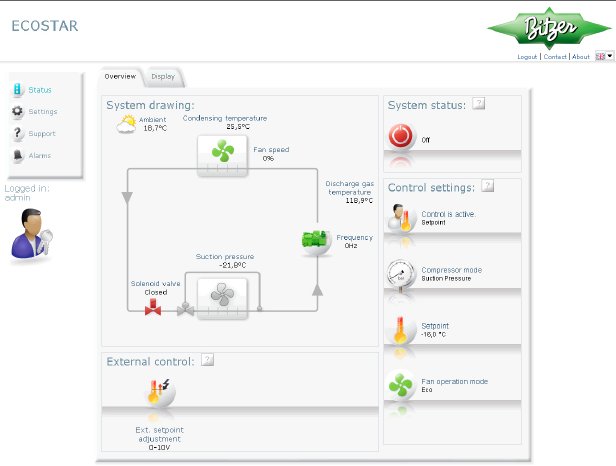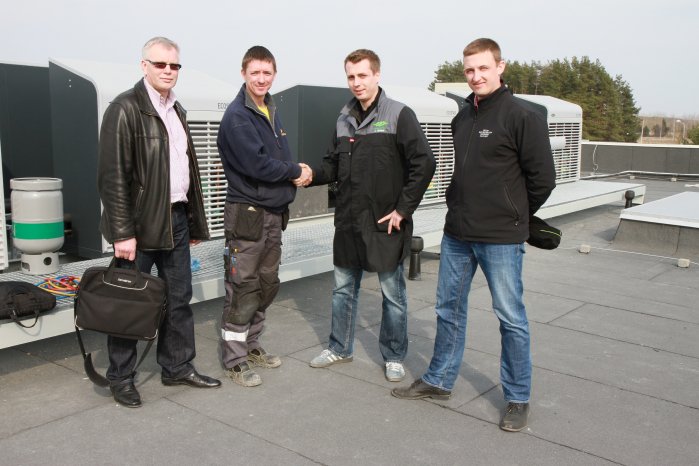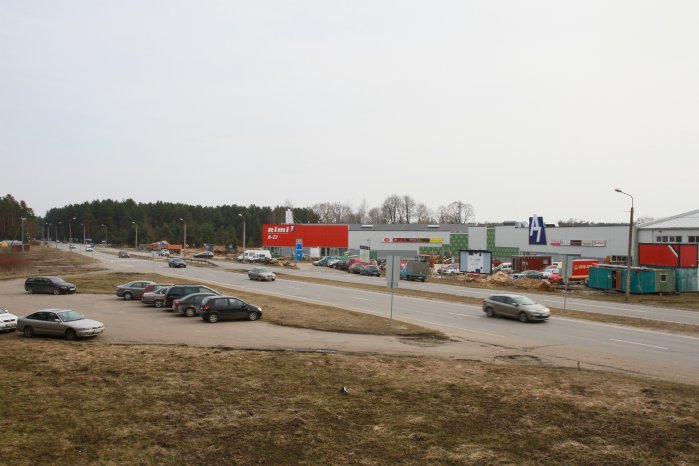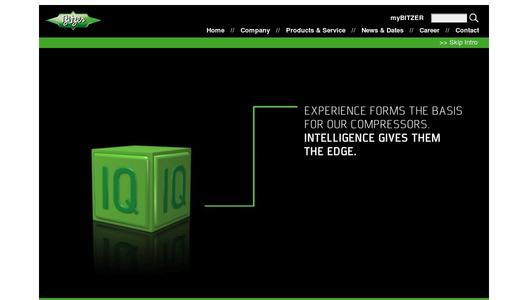There is a lot of building going on in the south of Riga – but the hammering, drilling, grinding and rumbling are especially loud as you approach one particular building site right on the edge of the city by the motorway leading to Vilnius. There, a complex of buildings known as the A7 shopping center is soon to open its doors. A German–Latvian team of experts is currently making the final preparations on top of the flat roof of the supermarket belonging to the RIMI Baltic chain, before performing a trial run of the freshly installed ECOSTAR condensing units.
Space-saving installation and high-level operating safety
A total of nine ECOSTAR units are arranged in a compact rectangle in the center of the roof. On such a large area, this ensemble of silver casings looks inconspicuous and space-saving, a fact which Jan Grübel of BITZER Customer Support points out at the site. ‘That is one of the advantages of complete units of this kind consisting of compressor, condenser and control system in one. Instead of a bulky combined system which places heavy demands on the strength of the building, they opted for a “plug-and-play solution” which fits into just under 40 square meters,’ he explains further. A comparable combined system would need almost three times more space, and on top of that, a good proportion of the equipment would have to be accommodated not on the roof but inside the building. At the A7, the space they have saved has allowed them to set up an additional store. Another advantage is the system’s redundant layout. ‘If something leaks, only part of the refrigeration will stop working. This gives fitters time to look for the fault,’ explains Grübel.
Convenient monitoring via Modbus, WEB control and HD data log
Grübel has traveled to Riga together with Dieter Hildebrandt, Manager World Condensing Unit at BITZER, especially for the commissioning of the pilot project. Part of their job was to familiarize the Latvian fitters with the convenient technical features of what is to date the largest ECOSTAR system in the Baltic region. All of the controls and regulating equipment can be monitored remotely via Modbus. This enables the application parameters to be monitored easily from the office or even from home if necessary. The user can control user-friendly software to adjust the system’s settings manually via the Internet as well.
This new method of communicating also makes commissioning easier. While adjusting the system, a service technician can conveniently monitor and evaluate operating parameters using a tablet or netbook in the cold room. The remote-control setup also allows you to download the data log via the Internet and to evaluate the past four weeks in detail. With this information, a service technician can easily adjust the system and detect any faults that may exist.
But to help make sure that manual intervention doesn’t have to happen to begin with, BITZER uses an intelligent controller for the compressors and fans in its condensing units. Grübel explains, ‘As soon as the set limits are reached, the electronic controller intervenes and initiates the necessary measures.’ This active electronic speed-regulating system makes the overall system highly efficient and reduces operating costs.
As Grübel is speaking, Edgars Zalitis, chief service technician on-site for the installation company Daldehog Ltd., opens one of the ECOSTARs. In just a few moves, he has unscrewed the front cover and lifted off the grating. Together with Martins Podnieks, technical director at Latvian wholesaler MaxCool SIA, he goes through the settings, which include the compressor parameters. ‘We’ve set a minimum run time of two minutes,’ describes Zalitis. ‘We’re using a start-up delay of four minutes as a minimum interruption time. This protects the compressor and frequency converter against thermal overloads, especially when starting. These parameters ensure that the system has enough time to adjust itself optimally, and they minimize the on/off cycles which the system has to undergo when refrigerating at a low level.’
The automatic oil feedback function also catches the Latvian specialist’s attention. It prevents a well-known problem: oil finding its way into the system (especially in winter), due to the part-load area reducing the refrigerant mass flow. In such a scenario, the electronics trigger a protective mechanism that automatically raises the frequency of the compressor to 87 Hz so that the oil, which would otherwise be concentrated in the evaporator, can be better fed back into the compressor.
Suction-gas-cooled frequency inverters regulate the compressors
At the heart of each of the nine condensing units is a BITZER OCTAGON VARISPEED reciprocating compressor. There are two different types of these in the ECOSTAR system on the roof of the supermarket in Riga: two of the condensing units are equipped with the 4DC-7.F3Y-40S compressor, which, operating at a speed of 87 Hz, has a throughput of 47.3 m³/h. In each of the seven other ECOSTAR units, a type 4CC-9.F3Y-40S compressor running at 87 Hz develops a throughput of 57.4 m³/h of the refrigerant used in these systems, R404A. Suction-gas-cooled frequency inverters guarantee smoothly regulated energy-optimized operation in both types of compressors. The electronics also regulate the optimum fan speed in relation to the ambient temperature.
‘A total of 21 evaporators – which means refrigerated counters, chest freezers and refrigerated shelves – and 14 cold rooms are connected to the nine condensing units,’ calculates Zalitis, pointing to the suction and pressure lines coming out of each unit casing and disappearing into the concrete roof. ‘The piping system which connects the evaporating and condensing sides is a good 200 meters long. There are also 50 expansion valves built in,’ he adds.
Assuming a room temperature of 2°C at the cold storage cell, this ECOSTAR system delivers a nominal total refrigerating output of 140 kW. Assuming a room temperature of –20°C at the cold storage cell, then the nominal refrigerating output is still 19 kW. ‘And to ensure that this automatically controlled system can respond in the best possible way to changing conditions, we’ve included a reserve capacity of 10 to 15%. That is around 15 kW, which also serves to cover potential expansion in the connected refrigerating systems,’ adds Podnieks.
Generally speaking, the reserve dimension should be kept as low as possible in frequency inverter systems so as to guarantee the highest possible frequency spectrum, including in the part-load range.
‘Expensive electricity forced a rethink’
As Zalitis closes the ECOSTAR cover again, Uldis Osenieks, managing director at MaxCool, briefly explains why complete solutions like the ECOSTAR are currently popular in the Latvian market. Firstly, rising energy costs are hitting people hard in the Baltic states, as they are elsewhere. ‘Expensive electricity has forced a rethink. Many companies favor technologies that incorporate intelligent controllers as well as frequency-controlled compressors. This allows a significant reduction in operating costs.’ Furthermore, systems like this have another major benefit when it comes to installation. ‘You need less manpower to set up these systems on-site and get them working. It’s a complete product which you just have to connect.’
According to Osenieks, a clear sign of growing market interest is the fact that MaxCool has sold several dozen ECOSTAR units in Latvia within the past year. That is why he considers the fitting of the RIMI supermarket at the A7 shopping center to be an important pilot project which will pave the way for other applications in similarly large developments.
